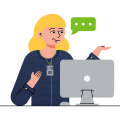We know that landing your first job (like working at a bakery, a retail store, or at a supermarket) can be challenging, but getting prepared and making a plan is a great place to start. Here is a list of things to think about when entering the workforce for the first time.
1. Create a job search plan
A great place to begin is to create a plan for your job search and start thinking about steps that you may need to take along the way. Check out the Work & Study Action Plan to get you started.
Understand your availability - consider your other commitments like school and sports and identify what is flexible and what is not. This will help you understand what kind of work you can look for (for example casual or part time). While considering your availability, think about when you can dedicate time to look for work and include these activities into your schedule.
Identify who your ‘cheer squad’ is: who you can turn to for advice and support along the way. This could include family, friends, Elders, teachers, school career counsellors or anyone else that you trust. If you’re over 18, you could also connect with a headspace Career Mentor.
2. Get started with these practical steps before you start job searching
- If you don’t already have a bank account, you’ll need to open one. You will also need a Tax File Number (TFN) and a superannuation account. You can wait and open a superannuation account with the employer’s default fund, just make sure you don’t do this every time you change jobs, try and stick with one super account at a time. Check out our guide on tax and super for more information.
- You will need identification. This could include a birth certificate, photo ID (e.g. a passport, student ID or drivers’ licence), or a Medicare card.
- Set up your voicemail and an appropriate email address so that employers can contact you. It could be helpful to set up a simple email address specifically for job applications (like your.name2001@xmail.com) so that you can easily keep track of job-related emails.
- It’s important to note that potential employers may look at your social media accounts so It could be useful to read more about your digital footprint and how to manage your privacy online.
- Consider your transport options. If getting your licence isn’t a possibility yet, plan out your options for transport to and from work. This might include public transport like buses or trains or asking a friend or family member for lifts.
- To get an idea of what you might get paid, do some research on minimum wages for the jobs you’re interested in. Fair Work have a fantastic Pay and Conditions Tool which can give you lots of this information relating to specific jobs.
- If you need support with some of these things, you could ask a family member or someone else you trust for help. If you’re aged 15-25, headspace Work & Study can also offer advice and guidance.
3. Identify what you want or need from a job
- Creating a career plan and considering what career or job suits you is a great way to identify what is important to you and what you’re looking for in a job.
- It can be good to reflect on WHY you want a job. Perhaps you simply want to be more financially independent, or maybe you want to learn new skills and gain experience. Whatever the reason is, it can be helpful to know this before you start applying for jobs because it may help you decide what types of jobs you’d like to look for. Your first job might not be your dream career, but can be a great opportunity to develop transferrable skills and experiences that will pave the way for future jobs in an industry that you’re interested in.
- If you have a disability or mental health difficulty, there might be things that you want or need in a job to help your transition into the workforce easier. You might like to read about reasonable adjustments or accommodations at work, as well as the pros and cons of disclosing and talking to your employer about your needs.
4. Start looking for jobs
- Now that you’ve created a plan, organised the practical things you need to get started and considered what you want or need in a job, it’s time to start job searching! We have lots of handy tips and tricks to help with this, including:
- If you haven’t already, make a list of businesses that you’d like to approach and start preparing for job applications. If you want to start by looking online, we have compiled a list of the top job sites in Australia. You could also print out a bunch of resumes to hand out to potential employers face-to-face. A lot of businesses strictly hire online (e.g. Woolworths, Coles, and Kmart) and will not accept in-person applications - so it is best to check their website before approaching them face-to-face.
- If you decide to approach a business in person, you could start by asking a manager if they are currently hiring. If they say no, don’t be discouraged! Thank them for their time and try somewhere else. If they say yes, offer them your resume and express your interest in working for them.
- Other options to consider include social media pages, signs in shop windows, emailing or calling businesses directly, school or community boards, and networking.
5. Prepare for job interviews
- Make sure you have some interview clothes that you feel comfortable and confident wearing. You can’t go wrong with something smart-casual like a button-down top and black pants with closed in shoes. If you’re not sure what to wear, check out these resources from SEEK or Youth Central for some more ideas.
- See our 8 tips to help you prepare for a job interview for information on researching the organisation, preparing for common interview questions and more.
- Businesses may conduct individual interviews or group interviews. You may not know which type of interview you’ll be offered as each business will have their own hiring processes, but it doesn’t hurt to prepare for both scenarios.
- Most interviewers will ask you behavioural questions, so check out how to ace behavioural questions.
- When you’re offered an interview, make sure you take note of the time of the interview, where you need to go, and who you’ll be meeting with.
- Bring your resume with you to the interview, and you can bring a notepad with important reminders like who you’re talking to and questions that you would like to ask the employer.
- You have the right to be treated fairly, even when you're applying for a job and participating in interviews. This means that employers can't say no to you just because of who you are, like your gender, race, disability or background. It could be helpful to be aware of the interview questions employers shouldn’t ask you.
6. Staying positive after receiving job rejections
While it might feel discouraging, most people won’t hear back or get an offer for every job they apply for. Stay positive, patient and persevere! If you feel like there must be a reason why you aren’t hearing back, there are a few things you can do:
- Review your resume and the actual job description. Firstly, do you meet the requirements of the job description, including experience, education or training? And if so, have you expressed that in your resume/job application?
- If you’ve been applying online, it doesn’t hurt to make sure your resume is ATS friendly as minor formatting errors may stop hiring managers from actually seeing your application. How to get your resume past the robots is a great resource that includes a checklist of dos and don’ts that may help get your application in front of an actual person.
- Be available for an interview and answer phone calls/emails as soon as you can. Many employers report ‘lack of availability of suitable candidates’ as one of their main recruitment difficulties. If you’re not easily contactable you may miss out on opportunities.
- Be realistic regarding your salary expectations. Employers have reported high salary expectations as another recruitment difficulty they experience. Remember to check your award and minimum wage on Fair Work’s Pay and Conditions tool as your pay rate is often not negotiable because it is based on the relevant award for that job.
- If you have the opportunity to ask for feedback on your application or interview, take it! If they have the time, some employers will be happy to offer feedback and advice on what you can do to improve your future applications.
7. Accept the job offer
You’ve done all your planning and preparation, aced the interview and been offered the job – congratulations! You will most likely receive a written letter of offer or employment contract at this stage. If you’re offered a job with a small business, this offer might be given verbally but you can request something in writing (e.g. an email confirming your offer of employment and other information like your pay rate and how many hours they’re offering you).
There is always some sort of paperwork that you will need to fill out and submit prior to your first shift. Read over this starting a new job checklist from Fair Work for more information on what kind of paperwork you’ll receive and other things you might need to bring on your first day.
8. Seek support
Entering the workforce for the first time can feel intimidating or overwhelming. It can also be a bit confusing but there is no shame in asking for some help! If you're aged 15 - 25 and want to talk through your options, get free and confidential support from headspace Work & Study by signing up for one-on-one support.
For support with your mental health and wellbeing, find your nearest headspace centre or access online and telephone support via eheadspace.
Australian HR Institute. (2023). AHRI’s Quarterly Australian Work Outlook.
Fair Work Ombudsman. (2023, November). Starting a new job checklist.
Indeed. (2023, May 7th). Interview Question: ‘Why Do You Want This Job?’.
Indeed. (2024, April 10th). Everything You Need to Know About Job Application (2024).
Indeed. (2024, April 16th). How to Ask for Feedback After an Interview (2024 Examples).
The headspace Content Reference Group oversee and approve clinical resources made available on this website.
Last reviewed May 2024.
Get professional support
If you feel you need help there are a range of ways we can support you.

